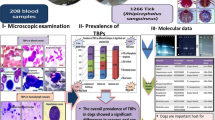Abstract
To identify DNA of the main tick-borne pathogens in dogs from Recife (Brazil), polymerase chain reactions were carried out on blood samples of dogs treated at the Veterinary Hospital of the Universidade Federal Rural de Pernambuco from March 2007 to June 2008. The detection of DNA was performed using specific primers. Amplicons were analyzed through electrophoresis and sequencing. A phylogenetic tree was constructed using the UPGMA method, revealing that the sequences were closely related to those of strains from other geographic regions. Among the 205 blood samples analyzed, 48.78% was positive for Anaplasma platys; 38.04% was positive for Ehrlichia canis; 7.31% was positive for Babesia canis vogeli; and 0.49% was positive for Hepatozoon canis and Mycoplasma haemocanis. Coinfection of two or three pathogens was found in 23.9% (49/205) of the dogs. The subspecies B. canis vogeli was identified. Infection by H. canis and M. haemocanis is reported for the first time in dogs in the state of Pernambuco (Brazil). The data indicate that the main tick-borne pathogens in dogs in this region are E. canis and/or A. platys, followed by B. canis vogeli.


Similar content being viewed by others
References
Aguirre E, Tesouro MA, Ruiz L, Amusategui I, Sainz A (2006) Genetic characterization of Anaplasma (Ehrlichia) platys in dogs in Spain. J Vet Med 53:197–200
Altschul SF, Gish W, Miller W, Myers EW, Lipman DJ (1990) Basic local alignment search tool. J Mol Biol 215:403–410
Baneth G, Barta JR, Shkap V, Martin DS, Macintire DK, Vincent-Johnson N (2000) Genetic and antigenic evidence supports the separation of Hepatozoon canis and Hepatozoon americanum at the species level. J Clin Microbiol 38:1298–1301
Brinson JJ, Messick JB (2001) Use of a polymerase chain reaction assay for detection of Haemobartonella canis in a dog. J Am Vet Med Assoc 218:1943–1945
Chalker VJ (2005) Canine mycoplasmas. Res Vet Sci 79:1–8
Criado-Fornelio A, Buling A, Cunha-Filho NA, Ruas JL, Farias NA, Rey-Valeiron C, Pingret JL, Etievant M, Barba-Carretero JC (2007) Development and evaluation of a quantitative PCR assay for detection of Hepatozoon sp. Vet Parasitol 150:352–356
Dantas-Torres F, Figueiredo LA, Faustino MAG (2004) Ectoparasitos de cães provenientes de alguns municípios da região metropolitana do Recife, Pernambuco, Brasil. Rev Bras Parasitol Vet 13:151–154
De La Fuente J, Torina A, Naranjo V, Nicosia S, Alongi A, Mantia FL, Kocan KM (2006) Molecular characterization of Anaplasma platys strains from dogs in Sicily, Italy. Vet Res 2:01–05
Dreher UM, De La Fuente J, Hofmam-Lehmann R, Meli ML, Pusterla N, Kocan KM, Woldehiwet Z, Braun U, Regula G, Straerk KDC, Lutz H (2005) Serologic cross-reactivity between Anaplasma marginale and Anaplasma phagocytophilum. Clin Diag Lab Immunol 2:1177–1183
Duarte SC, Linhares GFC, Romanowsky TN, Silveira Neto OJ, Borges LMF (2008) Assessment of primers designed for the subspecies-specific discrimination among Babesia cani canis, Babesia canis vogeli and Babesia canis rossi by PCR assay. Vet Parasitol 152:16–20
Ferreira RF, Cerqueira AMF, Pereira AM, Guimarães CM, Sá AG, Abreu FS, Massard CL, Almonsny NRP (2007) Anaplasma platys diagnosis in dogs: comparison between morphological and molecular tests. Int J Appl Res Vet Med 5:113–119
Felsenstein J (1985) Confidence limits on phylogenies: an approach using the bootstrap. Evolution 39:783–791
Foley JE, Harrus S, Poland A, Chomel B, Pedersen NC (1998) Molecular, clinical and pathologic comparison of two distinct strains of Haemobartonella felis in domestic cats. Am J Vet Res 59:1581–1588
Forlano MD, Teixeira KRS, Scofield A, Elisei C, Yotoko KSC, Fernandes KR, Linhares GFC, Ewing SA, Massard CL (2007) Molecular characterization of Hepatozoon sp. from Brazilian dogs and its phylogenetic relationship with other Hepatozoon spp. Vet Parasitol 145:21–30
Harrus S, Aroch I, Lavy E, Bark H (1997) Clinical manifestations of infectious canine cyclic thrombocytopenia. Vet Rec 141:247–250
Hua P, Yuhai M, Shide T, Yang S, Bohai W, Xiangrui C (2000) Canine ehrlichiosis caused simultaneously by Ehrlichia canis and Ehrlichia platys. Microbiol Immunol 44:737–739
Huang H, Unver A, Perez MJ, Orellana NG, Rikihisa Y (2005) Prevalence and molecular analysis of Anaplasma platys in dogs in Lara, Venezuela. Braz J Microbiol 36:211–216
Inokuma H, Fujii K, Matsumoto K, Okuda M, Nakagome K, Kosugi R, Hirakawa M, Onishi T (2002) Demonstration of Anaplasma (Ehrlichia) platys inclusions in peripheral blood platelets of a dog in Japan. Vet Parasitol 110:145–152
Labruna MB, Pereira MC (2001) Carrapatos em cães do Brasil. Clin Vet 30:24–32
Labarthe NV, Pereira MC, Barbarini O, Mckee W, Coimbra CA, Hoskins J (2003) Serologic prevalence of Dirofilaria immitis, Ehrlichia canis, and Borrelia burgdorferi infections in Brazil. Vet Ther 4:67–75
Martin AR, Brown GK, Dunstan RH, Roberts TK (2005) Anaplasma platys: an improved PCR for its detection in dogs. Exp Parasitol 109:176–180
Messick JB, Berent LM, Cooper SK (1998) Development and evaluation of a PCR-based assay for detection of Haemobartonella felis in cats and differentiation of H. felis from related bacteria by restriction fragment length polymorphism analysis. J Clin Microbiol 36:462–466
Messick JB, Walker PG, Raphael W, Berent L, Shi X (2002) Candidatus mycoplasma haemodidelphidis sp. Candidatus mycoplasma haemolamae sp. and Mycoplasma haemocanis haemotrophic parasites from a naturally infected opossum (Didelphis virginiana), alpaca (Lama pacos) and dog (Canis familiaris): phylogenetic and secondary structural relatedness of their 16S rRNA genes to other mycoplasmas. Int J Syst Evol Microbiol 52:693–698
Oyamada M, Davoust B, Boni M, Dereure J, Bucheton B, Hammad A, Itamoto K, Okuda M, Inokuma H (2005) Detection of Babesia canis rossi, B. canis vogeli, and Hepatozoon canis in dogs in a village of eastern Sudan by using a screening PCR and sequencing methodologies. Clin Diagn Lab Immunol 12:1343–1346
Passos LM, Geiger SM, Ribeiro MF, Pfister K, Zahler-Rinder M (2005) First molecular detection of Babesia vogeli in dogs from Brazil. Vet Parasitol 127:81–85
Pinyoowong D, Jittapalapon S, Suksawat F, Stich RW, Thamchaipenet A (2007) Molecular characterization of Thai Ehrlichia canis and Anaplasma platys strains detected in dogs. Infect Genet Evol 8:433–438
Rubini AS, Paduan KS, Cavalcante GG, Ribolla PEM, O’Dwyer LH (2005) Molecular identification and characterization of canine Hepatozoon species from Brazil. Parasitol Res 97:91–93
Rubini AS, Paduan KS, Lopes VVA, O’Dwyer LH (2008) Molecular and parasitological survey of Hepatozoon canis (Apicomplexa: Hepatozoidae) in dogs from rural area of São Paulo state, Brazil. Parasitol Res 102:895–899
Santos F, Coppede JS, Pereira ALA, Oliveira LP, Roberto PG, Benedetti RBR, Zucoloto LB, Lucas F, Sobreira L, Marins M (2007) Molecular evaluation of the incidence of Ehrlichia canis, Anaplasma platys and Babesia spp. in dogs from Ribeirão Preto, Brazil. Vet J 179:145–148
Seneviratna P, Weeasinghe N, Ariyadasa S (1973) Transmission of Heamobartonella canis by the dog tick, Rhipicephalus sanguineus. Res Vet Sci 14:112–114
Sneath PHA, Sokal RR (1973) Numerical taxonomy. Freeman, San Francisco, p 573
Solano-Gallego L, Lull J, Osso M, Hegarty B, Breitschwerdt E (2006) A serological study of exposure to arthropod-borne pathogens in dogs from northeastern Spain. Vet Res 37:231–244
Suksawat J, Pitulle C, Arraga-Alvarado C, Madrigal K, Hancock SI, Breitschwerdt EB (2001) Coinfection with three Ehrlichia species in dogs from Thailand and Venezuela with emphasis on consideration of 16S ribosomal DNA secondary structure. J Clin Microbiol 39:90–93
Tamura K, Dudley J, Nei M, Kumar S (2007) MEGA4: molecular evolutionary genetics analysis (MEGA) software version 4.0. Mol Biol Evol 24:1596–1599
Trapp SM, Dagnone AS, Vidotto O, Freire RL, Amude AM, Morais HSA (2006) Seroepidemiology of canine babesiosis and ehrlichiosis in a hospital population. Vet Parasitol 140:223–230
Uilenberg G, Franssen FFJ, Perie M, Spanjer AMM (1989) Three groups of Babesia canis distinguished and a proposal for nomenclature. Vet Quart 11:33–40
Wen B, Rikihisa Y, Mott JM, Greene R, Kim HY, Zhi N, Couto GC, Unver A, Bartsch R (1997) Comparison of nested PCR with imunofluorescent antibody assay for detection of Ehrlichia canis infection in dogs treated with doxycycline. J Clin Microbiol 35:1852–1855
Yabsley MJ, Mckibben J, Macpherson CN, Cattan PF, Cherry NA, Hegarty BC, Breitschwerdt EB, Connor TO, Chandrashekar R, Paterson T, Perea ML, Ball G, Fiesen S, Goedde J, Henderson B, Sylvester W (2008) Prevalence of Ehrlichia canis, Anaplasma platys, Babesia canis, Hepatozoon canis, Bartonella vinsonii berkhoffi, and Rickettsia spp. in dogs from Grenada. Vet Parasitol 151:279–285
Acknowledgments
The authors are grateful to the Brazilian fostering agencies Conselho Nacional de Desenvolvimento Científico e Tecnológico (CNPq) and Fundação de Amparo à Ciência e Tecnologia do Estado de Pernambuco (FACEPE) and EC (INCO 003691-MEDLABAB).
Author information
Authors and Affiliations
Corresponding author
Rights and permissions
About this article
Cite this article
Ramos, R., Ramos, C., Araújo, F. et al. Molecular survey and genetic characterization of tick-borne pathogens in dogs in metropolitan Recife (north-eastern Brazil). Parasitol Res 107, 1115–1120 (2010). https://doi.org/10.1007/s00436-010-1979-7
Received:
Accepted:
Published:
Issue Date:
DOI: https://doi.org/10.1007/s00436-010-1979-7




